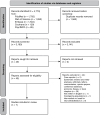Interventional neurorehabilitation for glioma patients: A systematic review
- PMID: 39554784
- PMCID: PMC11567740
- DOI: 10.1093/nop/npae066
Interventional neurorehabilitation for glioma patients: A systematic review
Abstract
Harnessing the neuroplastic potential of the human brain is being increasingly recognized as an important neuro-oncological paradigm to facilitate safe resection of brain tumors while preserving neurological function and quality of life. Interventional neurorehabilitation, employing both invasive and noninvasive neuromodulation techniques, represents an important emerging therapeutic strategy to induce or enhance neural plasticity to promote functional recovery in brain tumor patients. This study aimed to conduct a comprehensive review of interventional neurorehabilitation techniques for glioma patients.
Methods: In accordance with PRISMA guidelines, searches of Medline, Embase, Web of Science, APA PsycINFO, and Cochrane were undertaken from database inception to November 28, 2023. Studies reporting on neuromodulation applied to glioma patients were included.
Results: Seven studies reporting findings from 118 patients met the inclusion criteria. Three neuromodulation techniques were identified and included transcranial magnetic stimulation (TMS) reported in 5 out of 7 (71.4%) studies; transcranial direct current stimulation (tDCS); and continuous cortical electrical stimulation (cCES) using grid electrodes, reported in one study each. All studies applying noninvasive stimulation to ameliorate postoperative deficits demonstrated an improvement on at least one outcome measure. The 2 studies applying tDCS and cCES to induce plasticity reported evidence of functional reorganization.
Conclusions: There is emerging evidence of benefits of neuromodulation to improve postoperative outcome in glioma patients. In the current literature, noninvasive stimulation has shown to have a favorable safety profile. Large-scale, double-blind, sham-controlled trials are warranted to further investigate the effectiveness of these interventions for modulating different cognitive networks in patients undergoing glioma surgery.
Keywords: cognition; glioma; motor; rehabilitation; transcranial magnetic stimulation (TMS).
© The Author(s) 2024. Published by Oxford University Press on behalf of the Society for Neuro-Oncology and the European Association of Neuro-Oncology. All rights reserved. For commercial re-use, please contact reprints@oup.com for reprints and translation rights for reprints. All other permissions can be obtained through our RightsLink service via the Permissions link on the article page on our site—for further information please contact journals.permissions@oup.com.
Figures


References
-
- Duffau H, Mandonnet E.. The “onco-functional balance” in surgery for diffuse low-grade glioma: integrating the extent of resection with quality of life. Acta Neurochir (Wien). 2013;155(6):951–957. - PubMed
-
- Rahman M, Abbatematteo J, De Leo EK, et al. The effects of new or worsened postoperative neurological deficits on survival of patients with glioblastoma. J Neurosurg. 2016;127(1):123–131. - PubMed
Publication types
LinkOut - more resources
Full Text Sources
Miscellaneous

